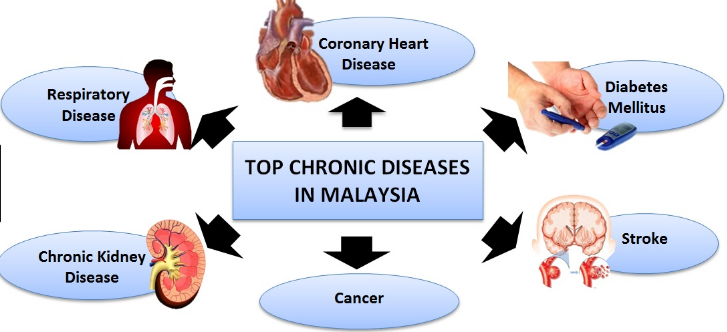
A non-communicable disease (NDC) is a disease that is not transmissible directly from one person to another. The diseases are of long duration and generally slow progression. They include Parkinson’s disease, autoimmune diseases, strokes, most heart diseases, most cancers, diabetes, chronic kidney disease, osteoarthritis, osteoporosis, Azheimer’s disease, cataracts and many more others.
A communicable disease is a disease that is spread from one person to another through a variety of ways that include:
- Physical contact with an infected person such as through sexual intercourse (HIV gonorrhea), through touch (staph infection) and oral transmission (influenza).
- Contact with a contaminated surface or object (Norwalk virus), food (Salmonella, E.coli), blood or water (Cholera).
- Bites from insects or animals capable of transmitting the disease (mosquitoes, fleas and plaque).
- Travel through air, such as measles or tuberculosis.
Key Differences
Facts About Communicable Diseases
- Communicable diseases are illnesses caused by viruses or bacteria that people spread to one another through contact with contaminated surfaces, bodily fluids, blood products, insect bites or through air.
- These types of diseases are not inheritable from one generation to another.
- Examples of communicable diseases include HIV/AIDS, Typhoid, Cholera, Ebola, hepatitis A, Flu, shigellosis, Tuberculosis, Zika, Rabies, Measles, MRSA, Pertussis, Hantavirus, West Nile Virus and Malaria.
- Many communicable diseases are treated by conventional methods.
- The diseases are mostly caused by pathogens, bacteria, fungus or virus.
- The diseases are acute in other words they last for a shorter period of time (if treated).
- The best way you can prevent yourself from getting infected is by avoiding any form of contact with infected person.
Facts About Non-Communicable Diseases
- Non communicable diseases are illnesses that are not transmissible directly from one person to another. They are typically of a long duration and progress slowly.
- The diseases can be inherited.
- Examples of non communicable diseases include cancer, neurological disorders, heart disease, diabetes, Rickets, autoimmune diseases, stroke, chronic kidney diseases, osteoarthritis, osteoporosis, Alzheimer’s disease and others.
- Non communicable diseases are treated conservatively or surgically.
- The disease may have different causes but the common risk factors are lifestyle, gender, and malnutrition, abnormalities in cell proliferation or hereditary factors.
- The diseases are chronic, in other words last for a long period of time.
- The best way you can prevent yourself from the diseases is by maintaining a healthy diet and exercising regularly.
Also Read: Difference Between Salmonella And Shigella
Difference Between Communicable and Non-communicable Diseases In Tabular Form
| Basis of Comparison | Communicable | Non-Communicable |
| Definition | Communicable diseases are illnesses caused by viruses or bacteria that people spread to one another through contact with contaminated surfaces, bodily fluids, blood products, insect bites or through air. | Non communicable diseases are illnesses that are not transmissible directly from one person to another. They are typically of a long duration and progress slowly. |
| Inheritance | These types of diseases are not inheritable from one generation to another. | The diseases can be inherited. |
| Examples | Examples of communicable diseases include HIV/AIDS, Typhoid, Cholera, Ebola, hepatitis A, Flu, shigellosis, Tuberculosis, Zika, Rabies, Measles, MRSA, Pertussis, Hantavirus, West Nile Virus and Malaria. | Examples of non communicable diseases include cancer, neurological disorders, heart disease, diabetes, Rickets, autoimmune diseases, stroke, chronic kidney diseases, osteoarthritis, osteoporosis, Alzheimer’s disease and others. |
| Treatment | Many communicable diseases are treated by conventional methods. | Non communicable diseases are treated conservatively or surgically. |
| Causes | They are mostly caused by pathogens, bacteria, fungus or virus. | They may have different causes but the common risk factors are lifestyle, gender, and malnutrition, abnormalities in cell proliferation or hereditary factors. |
| Longevity | The diseases are acute in other words they last for a shorter period of time (if treated). | The diseases are chronic, in other words last for a long period of time. |
| Prevention | The best way to prevent yourself from getting infected is by avoiding any form of contact with infected person. | The best way to prevent yourself from the diseases is by maintaining a healthy diet and exercising regularly. |
| Infecting Agent | Bacteria and Virus. | No infectious agent. |
Also Read: Difference Between Staphylococcus And Streptococcus Bacteria
Summary
Communicable diseases are illnesses caused by viruses or bacteria that people spread to one another through contact with contaminated surfaces, bodily fluids, blood products, insect bites or through air. Non communicable diseases on the other hand, are illnesses that are not transmissible directly from one person to another. They are typically of a long duration and progress slowly.